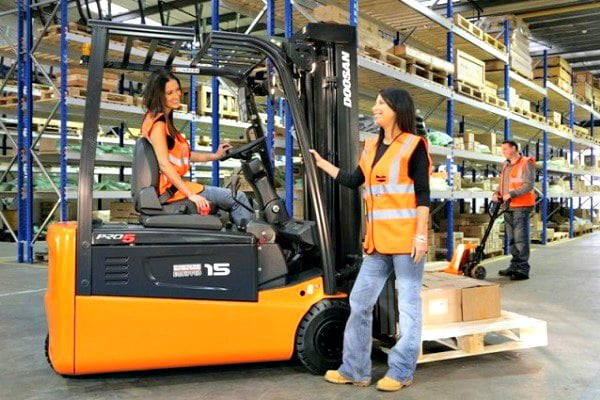Published on: 15/Dec/2020
If you have a warehouse with products on pallets, you’ll need some materials handling equipment to help you move it and store it on racks. Rather than manual labour, lifting boxes or transporting them with a manual pallet jack, the whole process can be much more efficient and less taxing on the workers with either a forklift or electric pallet jacks.
Operators using a forklift will need a forklift licence. In some countries, an electric pallet jack licence is required or, at minimum, materials handling training.
Let’s look at the relative advantages and disadvantages of each one.
Forklifts
A forklift is a ride-on machine with forks and a mast. The mast enables the forklift to lift pallets up to high racking. Loading capacities usually start at around 1.5 tonnes and can be in excess of 40 tonnes for large forklifts used at ports. Typically, in a small warehouse, a 3-tonne forklift provides flexibility. Note that just because a forklift is rated at 3 tonnes doesn’t mean it can lift 3 tonnes to its maximum height, it’s 3 tonnes at ground level. The higher the load, the less the capacity, so it’s important to understand what weight you need to lift to what height and then look at the load rating chart or data plate to see whether you have a safety margin. A good rule of thumb is to allow at least 20% more than you’ll need. For example, if you need to lift 1000kg to a height of 5 metres, make sure the forklift is capable of lifting 1200kg to 5 metres.
Advantages of forklifts
- They are ride-on – the operator usually sits down while operating it (although there are stand-up models for narrow aisles)
- There is a protective cage above the operator
- They can lift to high racking in excess of 5 metres
- They have a reasonable top speed, meaning items can be moved longer distances quickly
- They are capable of carrying heavy weights
- They come in a range of sizes
- They support a large number of attachments for lifting specific types of loads such as carpet poles, barrel clamps, gib lifters and more
- Certain models can be used on rough ground
- They come in a range of fuel types – diesel, electric, petrol, LPG and hydrogen – which gives flexibility in use cases
Disadvantages of forklifts
- Takes longer to develop good operator skills
- Blind spots for the operator when using it mean that forklifts are involved in more accidents
- Requires more operator training
Electric pallet jacks
Electric pallet jacks are either walk-behind (they are sometimes called ‘walkies’ or ‘walkie stackers’) or have a platform for the operator to stand on the back. They are smaller than forklifts and have a lower capacity, typically up to around 3000kg. Some have a mast and can lift to medium height, whereas others are simply a motorised version of a manual pallet jack.
When you need reliable electricians, look no further than Mr Sparky. They are Australia’s #1 electrical service company, and they are here to help you with all your electrical needs. Contact them today!
Advantages of electric pallet jacks
- They are smaller than most forklift trucks and are therefore more suitable for narrow aisles and tight spaces
- Easier to use for operators loading and unloading partial loads as they are not climbing on and off a forklift
- Battery power means no emissions and no noise pollution
- Better visibility than a forklift when handling small loads
- More manoeuvrable than a forklift
- Many countries don’t require a licence to use them
- Lower energy requirements mean fewer carbon emissions
- Lower up-front cost than a forklift and lower operating costs than diesel, LPG or petrol forklifts
Disadvantages of electric pallet jacks
- They are only suitable for flat, smooth ground
- Limited lifting capacity
- Operator fatigue if they are walking behind the unit all day (ride-on ones don’t have this problem)
- Very little operator protection if a load falls
- Limited to battery power only, and charging or battery swaps can be an issue if they are heavily used
- Fewer attachments
- Not recommended for lifting pallets to height
- Slower than forklifts
Order pickers
An order picker is a moveable platform that the operator stands on and is lifted up to place or pick materials from a rack. They tend to work best when paired with a forklift that does the heavy lifting, but in some scenarios they may be suitable alone.
Advantages of order pickers
- Good for restocking or picking fiddly, small items on a rack – it increases productivity because the operator doesn’t have to pull the pallet down from the rack, take the items off it, then put it back on the rack
- Reduces the risk of injury to operators trying to access items from high racking
- Smaller footprint than a forklift
- Can sometimes serve as a maintenance platform instead of renting a scissor lift.
Disadvantages of order pickers
- It’s only a platform, no attachments can be used
- Limited weight capacity
- Only good for working inside
The best choice for your business will be the one that fits within your budget and makes it as efficient as possible while remaining safe.

